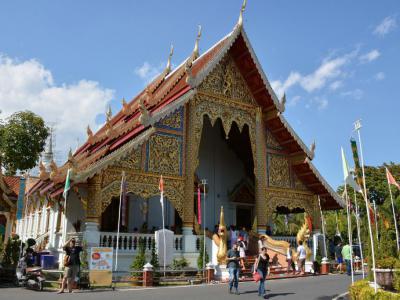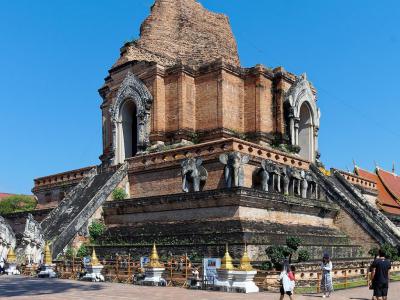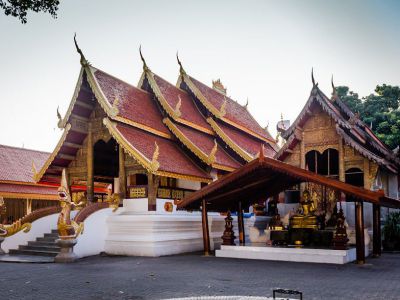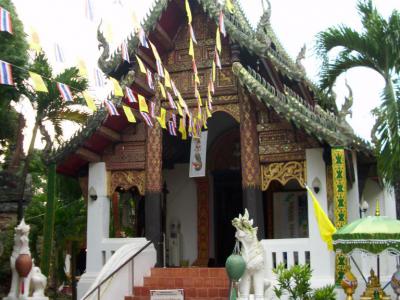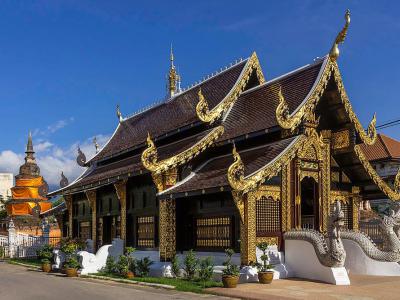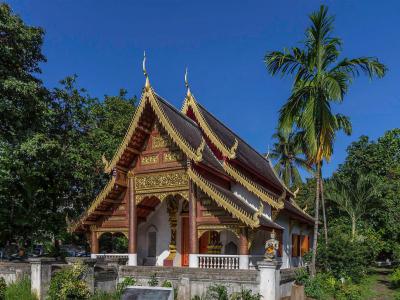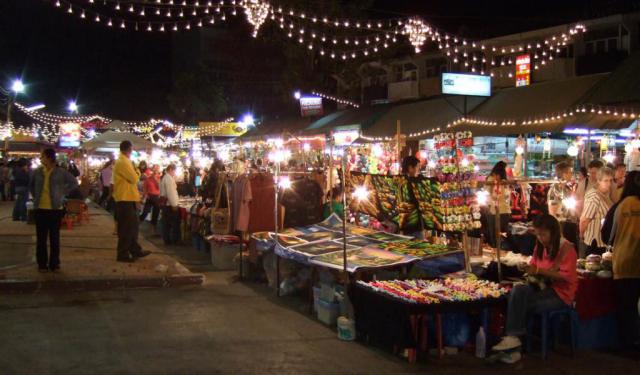Chiang Mai Temples Walking Tour (Self Guided), Chiang Mai
Amid the multitude of impressive sights in Chiang Mai, religious temples really stand out. The city isn't just about one or two of them but has over 300 ‘wats’, which is more than elsewhere in Thailand. Some of these temples are as old as the city itself and were built by the kings not only to demonstrate their faith, but also to show off their wealth and power.
In the past, apart from being places of worship, they also served as schools and hospitals. Today, the holy structures of Chiang Mai are very much as active as ever, representing invaluable bridges between the past and present, enabling people to maintain links with the timeless traditions of their ancestors.
The majority of Chiang Mai's temples are of the ‘Lanna’ style, characterized by curved wooden roofs pointing up at the top. Among them, Wat Chedi Luang complex in the middle of the Old City is a definite must-see. Loosely translating from the old Lanna language to “very big”, the enormous Luang temple certainly lives up to its name. Its main chedi stands 80 meters tall, which is the highest point in the Old City.
A walking distance from Luang is another not-to-be-missed – Wat Phra Singh. Thanks to a thorough renovation in the 19th century, followed by numerous licks of paint ever since, it has been one of the most visually impressive temples in Chiang Mai. Its main building steals the show with the iconic slanted Lanna-style roofs and intricately decorated façade that shines brightly in the sunlight.
To explore these and other temples of historic and cultural importance in Chiang Mai, take this self-guided walking tour.
In the past, apart from being places of worship, they also served as schools and hospitals. Today, the holy structures of Chiang Mai are very much as active as ever, representing invaluable bridges between the past and present, enabling people to maintain links with the timeless traditions of their ancestors.
The majority of Chiang Mai's temples are of the ‘Lanna’ style, characterized by curved wooden roofs pointing up at the top. Among them, Wat Chedi Luang complex in the middle of the Old City is a definite must-see. Loosely translating from the old Lanna language to “very big”, the enormous Luang temple certainly lives up to its name. Its main chedi stands 80 meters tall, which is the highest point in the Old City.
A walking distance from Luang is another not-to-be-missed – Wat Phra Singh. Thanks to a thorough renovation in the 19th century, followed by numerous licks of paint ever since, it has been one of the most visually impressive temples in Chiang Mai. Its main building steals the show with the iconic slanted Lanna-style roofs and intricately decorated façade that shines brightly in the sunlight.
To explore these and other temples of historic and cultural importance in Chiang Mai, take this self-guided walking tour.
How it works: Download the app "GPSmyCity: Walks in 1K+ Cities" from Apple App Store or Google Play Store to your mobile phone or tablet. The app turns your mobile device into a personal tour guide and its built-in GPS navigation functions guide you from one tour stop to next. The app works offline, so no data plan is needed when traveling abroad.
Chiang Mai Temples Walking Tour Map
Guide Name: Chiang Mai Temples Walking Tour
Guide Location: Thailand » Chiang Mai (See other walking tours in Chiang Mai)
Guide Type: Self-guided Walking Tour (Sightseeing)
# of Attractions: 6
Tour Duration: 1 Hour(s)
Travel Distance: 2.5 Km or 1.6 Miles
Author: vickyc
Sight(s) Featured in This Guide:
Guide Location: Thailand » Chiang Mai (See other walking tours in Chiang Mai)
Guide Type: Self-guided Walking Tour (Sightseeing)
# of Attractions: 6
Tour Duration: 1 Hour(s)
Travel Distance: 2.5 Km or 1.6 Miles
Author: vickyc
Sight(s) Featured in This Guide:
- Wat Phra Singh
- Wat Chedi Luang
- Wat Sum Pow
- Wat Umong Mahathera Chan
- Wat Sadeu Muang
- Wat Chiang Man
1) Wat Phra Singh (must see)
Wat Phra Singh is one of Chiang Mai’s most important temples and a major center of Buddhist devotion in Northern Thailand. Founded in the mid-14th century by King Pha Yu, it was originally built to house the ashes of his father, King Kham Fu, during the height of the Lanna Kingdom.
Its prominence grew when the Phra Buddha Sihing (commonly called Phra Singh) image arrived in 1367. The statue, considered a highly revered representation of the Buddha, gave the temple its name and continues to draw worshippers from across Thailand. During the Thai New Year, or Songkran festival, the image is paraded through the streets in a traditional procession, allowing people to pay respect by gently sprinkling water.
The temple complex showcases elegant examples of Lanna architecture. One of its most celebrated structures is the smaller Viharn Lai Kham, which houses the Phra Singh statue. The building features finely carved wooden details and interior murals illustrating Jataka tales and elements of Lanna culture. The larger Viharn Luang stands nearby with striking white pillars and a gilded Buddha image known as Phra Chao Thong Tip.
Additional structures add to the temple’s historical interest. The Ubosot, used for ordination ceremonies, displays decorative motifs inspired by Buddhist cosmology, while an ancient brick chedi dating back to 1345 offers insight into the earliest phases of the temple’s construction. A small elevated library within the grounds was designed to protect sacred manuscripts from humidity and pests.
Wat Phra Singh remains an active monastic community. Visitors may observe daily rituals or speak with monks in designated areas where they share information about Buddhist beliefs and meditation practices. Together, these features make the temple an important place for understanding both the religious and cultural traditions of Chiang Mai.
Tip:
The monks here are serious and prefer not to have pictures of the Buddha statues, believing this to be disrespectful. They also discourage the use of the Buddha as art, asking that representations be confined to shrines, whether public or private.
Its prominence grew when the Phra Buddha Sihing (commonly called Phra Singh) image arrived in 1367. The statue, considered a highly revered representation of the Buddha, gave the temple its name and continues to draw worshippers from across Thailand. During the Thai New Year, or Songkran festival, the image is paraded through the streets in a traditional procession, allowing people to pay respect by gently sprinkling water.
The temple complex showcases elegant examples of Lanna architecture. One of its most celebrated structures is the smaller Viharn Lai Kham, which houses the Phra Singh statue. The building features finely carved wooden details and interior murals illustrating Jataka tales and elements of Lanna culture. The larger Viharn Luang stands nearby with striking white pillars and a gilded Buddha image known as Phra Chao Thong Tip.
Additional structures add to the temple’s historical interest. The Ubosot, used for ordination ceremonies, displays decorative motifs inspired by Buddhist cosmology, while an ancient brick chedi dating back to 1345 offers insight into the earliest phases of the temple’s construction. A small elevated library within the grounds was designed to protect sacred manuscripts from humidity and pests.
Wat Phra Singh remains an active monastic community. Visitors may observe daily rituals or speak with monks in designated areas where they share information about Buddhist beliefs and meditation practices. Together, these features make the temple an important place for understanding both the religious and cultural traditions of Chiang Mai.
Tip:
The monks here are serious and prefer not to have pictures of the Buddha statues, believing this to be disrespectful. They also discourage the use of the Buddha as art, asking that representations be confined to shrines, whether public or private.
2) Wat Chedi Luang (must see)
Wat Chedi Luang is one of Chiang Mai’s most historically significant temples, located at the center of the Old City. Its name refers to the massive stupa that once dominated the skyline, originally constructed in the 14th century by King Saen Muang Ma to enshrine the ashes of his father, King Ku Na. Over the following decades, later rulers enlarged the structure, and by the mid-15th century it stood at an estimated 82 meters high, making it one of the tallest structures in the Lanna Kingdom.
For a brief period, Wat Chedi Luang also housed the revered Emerald Buddha, today kept in Bangkok’s Grand Palace. After an earthquake in the 16th century caused major damage to the chedi’s upper portion, the statue was relocated to Luang Prabang, and the temple gradually fell into partial ruin.
In the 1990s, restoration efforts supported by UNESCO and the Japanese government stabilized the structure. However, the reconstruction of the upper tiers in a Central Thai style, rather than traditional Lanna design, sparked debate among local historians and architects. The chedi remains intentionally truncated, preserving a sense of its dramatic history.
Visitors can still admire the weathered brick base, accessed by steep stairways guarded by stone nagas and elephants. The large main assembly hall, contains Phra Chao Attarot, a respected statue of the Buddha in a graceful standing posture. An ancient Dipterocarp tree grows nearby and is traditionally believed to protect the city. Adjacent to it is the city pillar, housed in a small shrine dedicated to guardian spirits that watch over Chiang Mai.
Wat Chedi Luang remains an active spiritual center. Visitors may witness monks performing daily rituals or join a Monk Chat session hosted on the grounds, where monastics share insights into Buddhist teachings and life in the temple community.
Tip:
If possible, go at (or stay until) nightfall to walk around this one. You can feel the peacefulness and the ambiance going after dark because these parts of the city are full of magic!
For a brief period, Wat Chedi Luang also housed the revered Emerald Buddha, today kept in Bangkok’s Grand Palace. After an earthquake in the 16th century caused major damage to the chedi’s upper portion, the statue was relocated to Luang Prabang, and the temple gradually fell into partial ruin.
In the 1990s, restoration efforts supported by UNESCO and the Japanese government stabilized the structure. However, the reconstruction of the upper tiers in a Central Thai style, rather than traditional Lanna design, sparked debate among local historians and architects. The chedi remains intentionally truncated, preserving a sense of its dramatic history.
Visitors can still admire the weathered brick base, accessed by steep stairways guarded by stone nagas and elephants. The large main assembly hall, contains Phra Chao Attarot, a respected statue of the Buddha in a graceful standing posture. An ancient Dipterocarp tree grows nearby and is traditionally believed to protect the city. Adjacent to it is the city pillar, housed in a small shrine dedicated to guardian spirits that watch over Chiang Mai.
Wat Chedi Luang remains an active spiritual center. Visitors may witness monks performing daily rituals or join a Monk Chat session hosted on the grounds, where monastics share insights into Buddhist teachings and life in the temple community.
Tip:
If possible, go at (or stay until) nightfall to walk around this one. You can feel the peacefulness and the ambiance going after dark because these parts of the city are full of magic!
3) Wat Sum Pow
When exploring the vibrant city of Chiang Mai, the numerous temples are an essential part of the cultural experience. Among them, Wat Sum Pow, also known as Wat Sam Phao, stands out as a testament to the rich history and architectural heritage of the region. This magnificent Buddhist temple dates back to the reign of the Mang Rai dynasty, showcasing the traditional Lanna style that was prevalent during that era.
Located along the famous Rachadamnoen Road, Wat Sum Pow immediately captures visitors' attention with its striking entrance adorned by magnificent dragon sculptures. These mythical creatures serve as guardians, symbolizing protection and power, inviting visitors to step into a world of spirituality and serenity. As you enter the temple grounds, you are greeted by a majestic golden Buddha image, exuding a sense of tranquility and reverence.
The complex of Wat Sum Pow is a captivating sight, showcasing the unique blend of architectural elements and decorations used by the Lanna people, the early inhabitants of the region. The intricate design, elaborate carvings, and ornate detailing are a testament to the skilled craftsmanship of the Lanna artisans, leaving visitors in awe of the temple's beauty and historical significance.
The temple grounds feature stalls where visitors can purchase tiny souvenirs and merchandise, allowing them to take home a piece of the temple's charm and spirituality. These offerings add a touch of local flavor to the temple visit and serve as reminders of the profound cultural experience found within Wat Sum Pow.
Located along the famous Rachadamnoen Road, Wat Sum Pow immediately captures visitors' attention with its striking entrance adorned by magnificent dragon sculptures. These mythical creatures serve as guardians, symbolizing protection and power, inviting visitors to step into a world of spirituality and serenity. As you enter the temple grounds, you are greeted by a majestic golden Buddha image, exuding a sense of tranquility and reverence.
The complex of Wat Sum Pow is a captivating sight, showcasing the unique blend of architectural elements and decorations used by the Lanna people, the early inhabitants of the region. The intricate design, elaborate carvings, and ornate detailing are a testament to the skilled craftsmanship of the Lanna artisans, leaving visitors in awe of the temple's beauty and historical significance.
The temple grounds feature stalls where visitors can purchase tiny souvenirs and merchandise, allowing them to take home a piece of the temple's charm and spirituality. These offerings add a touch of local flavor to the temple visit and serve as reminders of the profound cultural experience found within Wat Sum Pow.
4) Wat Umong Mahathera Chan
Wat Umong Mahathera Chan, located in the heart of Chiang Mai's old town, is a venerable temple that holds a rich history dating back 700 years. The temple's name pays homage to the renowned monk Mahathera Chand, who lived in Chiang Mai during the 14th and 15th centuries and frequently resided at this sacred site. One fascinating aspect of the temple's past is the underground tunnel, from which the name "Umong" derives, that once connected the chedi to the viharn.
Within the temple grounds, there are a viharn, an ubosot, and two chedis. Notably, an ancient Bodhi tree, over 700 years old, stands as a living testament to the temple's antiquity. The viharn stands out with a unique Lanna architectural style, featuring a two-tier roof adorned with green and gold nagas. Chofa eagle finials top the roof, adding elegance. Two majestic chinthe lions guard the entrance, exuding protection and reverence.
In the dimly lit viharn, strategically placed lights create a mesmerizing effect on the central Buddha image. The floor has plain tiles, and the grand ceiling is supported by five massive pairs of teak columns. The walls are adorned with vibrant murals depicting the Buddha's previous lives and scenes from the Jataka, providing insights into Buddhism's teachings. The main altar features four Buddha images, with the principal one exuding serenity in the Subduing Mara mudra. Three smaller Buddha images accompany it, including one made of black granitic stone, adding to the temple's religious artifacts.
Within the temple grounds, there are a viharn, an ubosot, and two chedis. Notably, an ancient Bodhi tree, over 700 years old, stands as a living testament to the temple's antiquity. The viharn stands out with a unique Lanna architectural style, featuring a two-tier roof adorned with green and gold nagas. Chofa eagle finials top the roof, adding elegance. Two majestic chinthe lions guard the entrance, exuding protection and reverence.
In the dimly lit viharn, strategically placed lights create a mesmerizing effect on the central Buddha image. The floor has plain tiles, and the grand ceiling is supported by five massive pairs of teak columns. The walls are adorned with vibrant murals depicting the Buddha's previous lives and scenes from the Jataka, providing insights into Buddhism's teachings. The main altar features four Buddha images, with the principal one exuding serenity in the Subduing Mara mudra. Three smaller Buddha images accompany it, including one made of black granitic stone, adding to the temple's religious artifacts.
5) Wat Sadeu Muang
Wat Sadeu Muang, also known as Wat Inthakin Sadeu Muang, holds a significant place in the history of Chiang Mai. Legend has it that the city pillar called "Inthakin" was erected in 1296 by King Mangrai when he founded the city of Chiang Mai. The name "Wat Sadeu Muang" translates to "Temple of the Naval of the City," emphasizing its central and pivotal position in the old town.
The historical Inthakin pillar, which was believed to offer protection against misfortune, stood within the temple until it was moved by King Kawila in 1800 to Wat Chedi Luang. Today, the Inthakin Festival is celebrated annually around May, where the pillar is venerated, and offerings are made during the week-long festivities.
Located next to the Three King's Monument in the heart of the old town, Wat Sadeu Muang is one of the most frequently visited temples in Chiang Mai. Its viharn, a prayer hall, is a stunning example of Lanna temple architecture. The viharn's exterior is adorned with dark teak, coated in almost black lacquer, and embellished with beautiful gilt decorations, creating an exquisite visual appeal.
The temple's interior exudes a dark and atmospheric ambiance due to the use of dark teak and wooden bars in the windows, which allow limited natural light inside. The pillars and walls are richly adorned with floriated gilding, and panels display intricate carvings depicting scenes from Buddhist texts, further adding to the temple's cultural and historical significance.
The historical Inthakin pillar, which was believed to offer protection against misfortune, stood within the temple until it was moved by King Kawila in 1800 to Wat Chedi Luang. Today, the Inthakin Festival is celebrated annually around May, where the pillar is venerated, and offerings are made during the week-long festivities.
Located next to the Three King's Monument in the heart of the old town, Wat Sadeu Muang is one of the most frequently visited temples in Chiang Mai. Its viharn, a prayer hall, is a stunning example of Lanna temple architecture. The viharn's exterior is adorned with dark teak, coated in almost black lacquer, and embellished with beautiful gilt decorations, creating an exquisite visual appeal.
The temple's interior exudes a dark and atmospheric ambiance due to the use of dark teak and wooden bars in the windows, which allow limited natural light inside. The pillars and walls are richly adorned with floriated gilding, and panels display intricate carvings depicting scenes from Buddhist texts, further adding to the temple's cultural and historical significance.
6) Wat Chiang Man
Chiang Mai's oldest temple, Wat Chiang Man was built in 1296 by the Lanna King Mengrai who laid the foundations of the city. It is said that King Mengrai lived at the temple while his palace was being built. A stele dated 1581 near the Ubosot records that the foundation of the city of Chaing Mai was on April 12th, 1296 at 4 pm.
The small Viharn or assembly hall in the Wat Chiang Man complex contains the crystal Buddha which once belonged to Chama Devi the queen of Haripunchai. King Mengrai burned the kingdom of Haripunchai and founded Chiang Mai. The Crystal Buddha dates back to the year 663 AD. The other statue in the Viharn is the Marble Buddha. Locals pray to the idol for rain and on April 1st a rain festival is held annually. The large Viharn has the oldest Buddhist statue in Chiang Mai. Installed in the year 1465, it depicts the Buddha holding a begging bowl. There is a 15th-century Stupa with carved elephants on its stone walls showing the influence of monks from Sri Lanka. The temple complex also has a repository of religious scriptures and a lotus pond.
Why You Should Visit:
If you enjoy architecture, this will blow you away. The main temple is over the top with decorations and ornateness. Deep reds and gold accentuate everything.
The details on the outside of the buildings are breathtaking when the sun hits them. The complex is immaculately kept all of the time.
Tip:
The Tha Phae Gate along the river is on the way to Wat Chiang Man if walking from the Night Bazaar direction and is worth a quick 10 min stop off also – nice opportunity for a photo!
The small Viharn or assembly hall in the Wat Chiang Man complex contains the crystal Buddha which once belonged to Chama Devi the queen of Haripunchai. King Mengrai burned the kingdom of Haripunchai and founded Chiang Mai. The Crystal Buddha dates back to the year 663 AD. The other statue in the Viharn is the Marble Buddha. Locals pray to the idol for rain and on April 1st a rain festival is held annually. The large Viharn has the oldest Buddhist statue in Chiang Mai. Installed in the year 1465, it depicts the Buddha holding a begging bowl. There is a 15th-century Stupa with carved elephants on its stone walls showing the influence of monks from Sri Lanka. The temple complex also has a repository of religious scriptures and a lotus pond.
Why You Should Visit:
If you enjoy architecture, this will blow you away. The main temple is over the top with decorations and ornateness. Deep reds and gold accentuate everything.
The details on the outside of the buildings are breathtaking when the sun hits them. The complex is immaculately kept all of the time.
Tip:
The Tha Phae Gate along the river is on the way to Wat Chiang Man if walking from the Night Bazaar direction and is worth a quick 10 min stop off also – nice opportunity for a photo!
Walking Tours in Chiang Mai, Thailand
Create Your Own Walk in Chiang Mai
Creating your own self-guided walk in Chiang Mai is easy and fun. Choose the city attractions that you want to see and a walk route map will be created just for you. You can even set your hotel as the start point of the walk.
Shopping and Food Walking Tour
One of the reasons tourists visit Chiang Mai is shopping. Indeed, this city is fit to captivate anyone with its shopping opportunities, especially when it comes to diverse and unique goods such as silk, silver, clothing, ceramics, antiques, Buddhist art, lacquer and neilloware, of consistently good value and quality and at affordable prices. Chiang Mai is one of the cheapest places to shop in... view more
Tour Duration: 1 Hour(s)
Travel Distance: 1.3 Km or 0.8 Miles
Tour Duration: 1 Hour(s)
Travel Distance: 1.3 Km or 0.8 Miles
Chiang Mai Introduction Walking Tour
Legend holds that in 1296, King Mangrai sought a sacred site for his new city by releasing a white elephant into the forest. The creature climbed a mountain, trumpeted three times, knelt to rest, and then died. Taking this as a divine sign, the king erected a temple at that spot—today’s sacred Wat Doi Suthep.
Chiang Mai’s name literally means “new city” in Thai, reflecting its role... view more
Tour Duration: 2 Hour(s)
Travel Distance: 3.3 Km or 2.1 Miles
Chiang Mai’s name literally means “new city” in Thai, reflecting its role... view more
Tour Duration: 2 Hour(s)
Travel Distance: 3.3 Km or 2.1 Miles
The Most Popular Cities
/ view all



